Spiders
Spiders (order Araneae) are air-breathing chelicerate arthropods that have eight legs, and chelicerae modified into fangs that inject venom. They are the largest order of arachnids and rank seventh in total species diversity among all other groups of organisms. Spiders are found worldwide on every continent except for Antarctica, and have become established in nearly every ecological niche with the exception of air and sea colonization Most spiders will only bite humans in self-defense, and few produce worse effects than a mosquito bite or bee-sting. Most of those with medically serious bites, such as recluse spiders and widow spiders, are shy and bite only when they feel threatened, although this can easily arise by accident.
Yellow Sac Spider
Cheiracanthium
Appearance
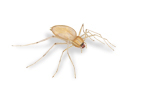
• Pale in colour, abdomen can be yellow or beige with a faint dark stripe running lengthwise.
• 1/4 to 3/8 inches long.
• 4 pairs of legs, the 1st pair longer than the 4th.
• Eight similarly-sized dark eyes arranged in two horizontal rows.
Lifecycle
• A female produces around 5 egg sacs each with 30 to 48 eggs. The female may produce several egg masses during her lifetime.
• Eggs are laid in Autumn.
• Spiderlings emerge the following Spring.
• Approximately 30 percent of adult males get eaten by females after mating.
Habits
• Feeding - usually small insects.
• Location – They build a silken tube or sac (instead of a web) in a protected area which is used as their daytime retreat.
• Externally this can be within a leaf or under logs; Indoors this can be or at the junction of a wall and ceiling or behind pictures and shelves. They are normally outdoor spiders, but will set-up indoors if there are small insects available. They are likely to enter homes during early Autumn when their outdoor food supply decreases.
• Visibility - Adults can be seen from April through November. They emerge at night to look for food. They drop to the floor to seek cover when disturbed.
• Bite - Their bite is sharp and painful amd will cause erythema and swelling. A wheal may develop, producing a necrotic area which can take eight weeks to heal. Pain or numbness at the site of the bite may be followed by sweating and nausea lasting for up to 24 hours.
Brown Recluse Spiders
Loxosceles reclusa
Appearance
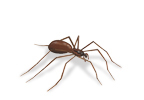
• 1/4 to 3/4 inch long.
• Brown or deep yellow color.
• Long, thin, brown legs covered with fine hairs.
• Six eyes, arranged in pairs in a semicircle.
• Often called ‘fiddleback’ or ‘violin’ spiders because of the violin-shaped marking on the top surface which points from the head area toward the abdomen.
Lifecycle
• Eggs are laid primarily from May to July.
• The female lays about 50 eggs in an off-white silky sac approx 2/3 inch diameter.
• Spiderlings emerge around 1 month later.
• It takes on average one year to reach the adult stage.
• Adults can live 1-2 years.
Habits
• Locations - They prefer secluded, dark, undisturbed sites indoors or outdoors. Indoors, they may be found in attics, basements, closets, ductwork, in storage boxes, shoes or behind furniture. Externally they may be found in barns, storage sheds, garages, under logs, loose stones and stacks of lumber.
• Feeding - They preferring dead insects. They can survive about 6 months without food or water.
• Visibility - The sac serves as the spider's daytime retreat. They tend to look for food at night.
• Bite – They only bite when crushed, handled or disturbed. Both sexes are venomous. A human’s reaction to the bite depends on the amount of venom injected and an individual's sensitivity to it - some people are unaffected, others may feel a pinprick, others a stinging sensation followed by intense pain. Some may not be aware of the bite for 2 to 8 hours.
Common House Spider
Family Diaspidae
Appearance
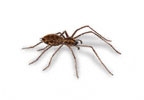
• Adult – body length excluding legs 6 – 10mm. Yellow brown body with faint markings. Abdomen pale grey brown with short hairs.
Lifecycle
• The egg sac produced by the female is spherical, covered with a layer of silk and placed within the web structure.
• The male will mate several times with the female before dying.
• Adults may live for several years.
Habits
• Found in buildings, sheds and wa.
• This spider produces a sheet web.
Harvestman Spider
Phalangium Opilio
Appearance
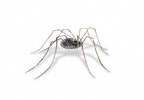
• Adult – 3.5–9mm body. The upper body surface has light grey/brown pattern, the lower surface is typically cream.
Lifecycle
• The females lay eggs in moist soil.
• The eggs survive through winter and hatch in the spring.
• Only one batch of eggs is laid each year.
Habits
• They live in fields and forests and climb tree trunks or look for food on the ground.
• They feed on many soft bodied arthropods, including aphids, caterpillars, beetle larvae, and small slugs.
Wolf Spider
Trochosa ruricola
Appearance
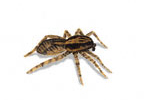
• Adult female: 8 mm; male - 6 mm. They are generally brown to grey in colour.
Lifecycle
• Wolf spider mothers carry their egg sacs around with them attached to spinnerets under the abdomen.
• When the young spiderlings hatch, they climb onto their mother's back where they live for the first few weeks of life.
Habits
• They hunt at night but spend the day hidden amongst moss and decaying matter.
• They live in a shallow burrow, with an open and unadorned entrance.
Zebra Spider
Salticus scenicus
Appearance

• Adult – body length excluding legs 5-6mm. Body black/white stripes. Legs are short, robust and hairy.
Lifecycle
• Females stay with the egg sacs and guard the newly hatched young. The spiderlings leave the mother after their second moult.
Habits
• Found in houses and gardens.
• They hunt their prey, so do not produce a web.
• Often seen jumping.


